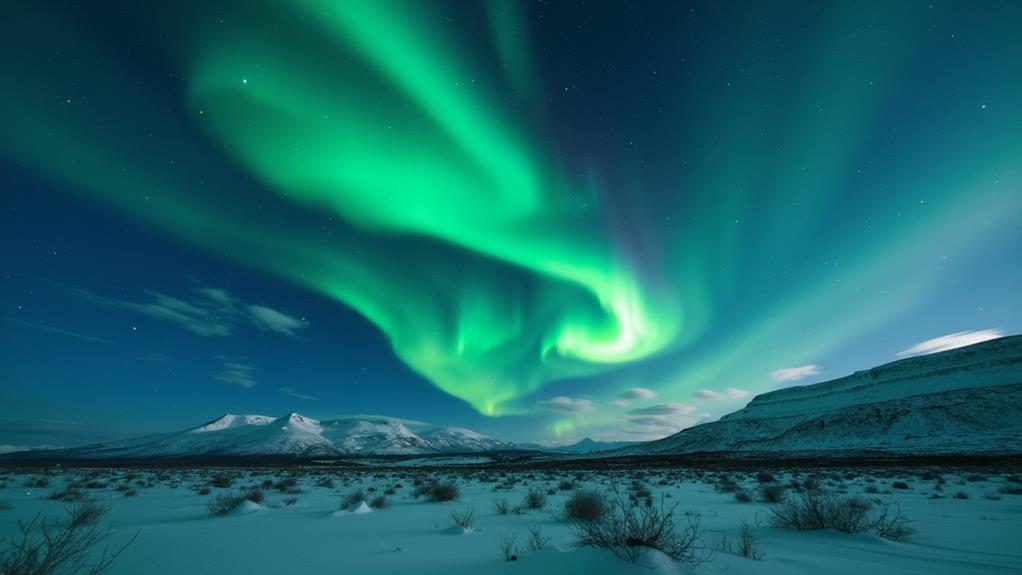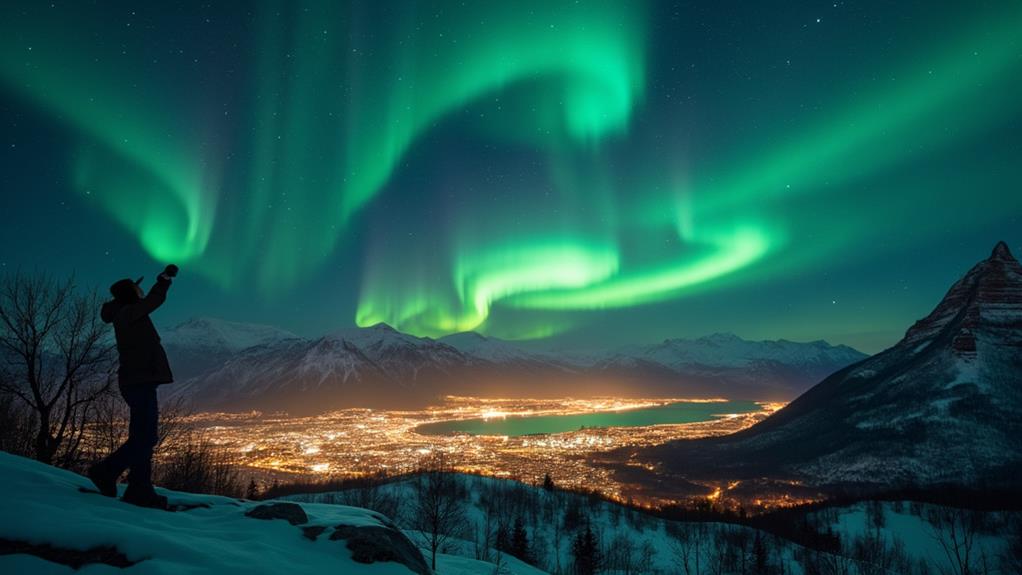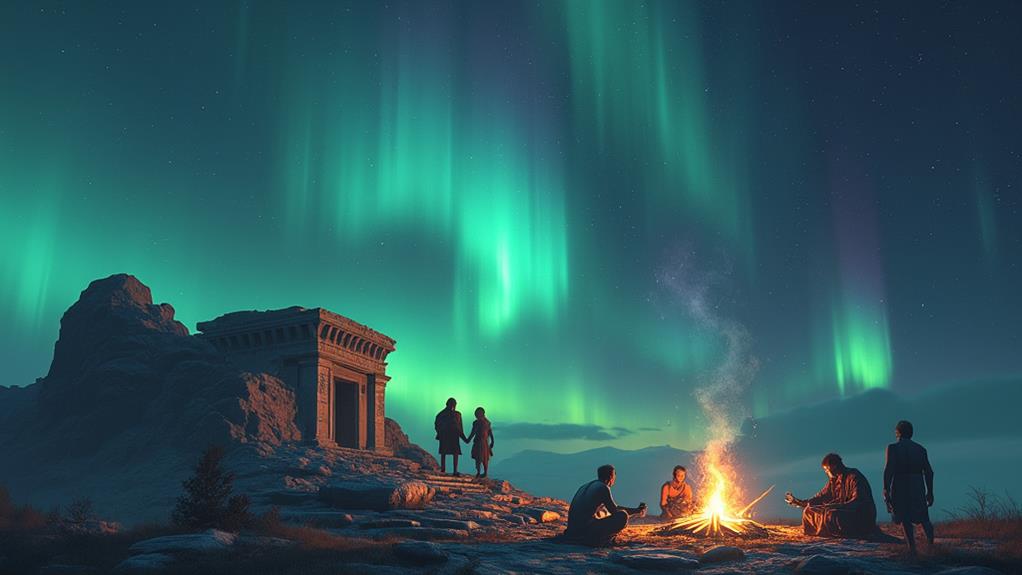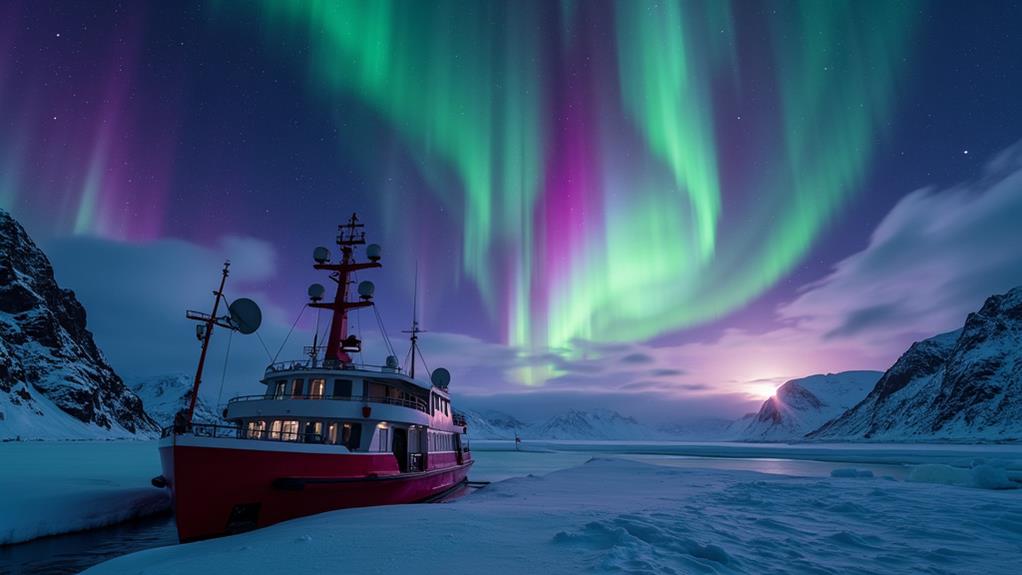The Northern Lights and the Midnight Sun: A Unique Arctic Experience
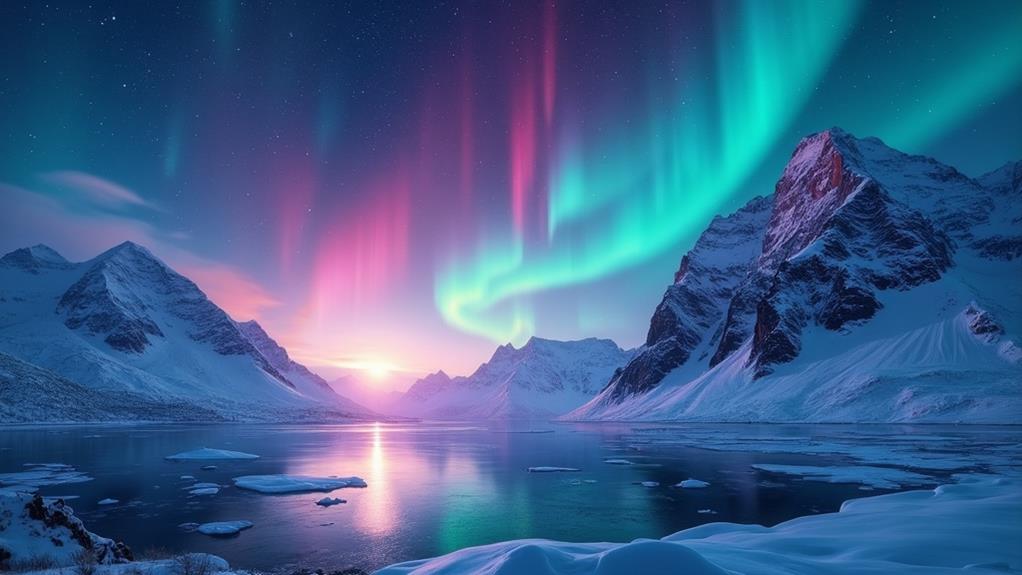
Imagine standing under a sky that never darkens, where you can golf or kayak at midnight, and later witness the dazzling hues of the Northern Lights dancing across the Arctic night. This unique juxtaposition of the Midnight Sun and the aurora borealis offers an unparalleled experience in places like Svalbard and the North Cape. But what is it about these phenomena that draws people from around the globe? How do they shape the cultural fabric and daily life of Arctic communities? There is much more to uncover about this enchanting blend of natural wonders.
Geographic Distribution
The midnight sun is a captivating phenomenon primarily observed in regions north of the Arctic Circle and south of the Antarctic Circle. This natural wonder occurs during the summer months at latitudes approximately between 65°44' and 90° north or south.
For example, in Murmansk, Russia, the midnight sun is visible from 22 May to 22 July, offering 62 days of continuous daylight. Further north, in the Svalbard archipelago, it extends from 20 April to 22 August, resulting in over 120 days of uninterrupted daylight. This makes for an extraordinary experience.
At the Arctic Circle, the midnight sun is visible from about 12 June to 1 July. If you visit North Cape, the northernmost point in Europe, you can experience this phenomenon from 14 May to 29 July, totaling 77 days. Even locations just outside the polar circles, such as Iceland, can witness the midnight sun due to atmospheric refraction effects. This unique geographic distribution ensures that the midnight sun creates unforgettable memories in some of the most remote and beautiful parts of our planet.
Polar Circle Proximity
When you venture near the polar circles, the proximity to these regions significantly influences the duration of the midnight sun. The farther north you go, the longer you can experience continuous daylight, a unique phenomenon and one of the main attractions of the Arctic Circle and surrounding polar regions.
Consider these notable examples:
- Murmansk, Russia: Situated just north of the Arctic Circle, Murmansk enjoys the midnight sun for 62 days, from May 22 to July 22.
- Svalbard, Norway: In the Svalbard archipelago, the midnight sun lasts approximately 120 days, from April 20 to August 22.
- North Pole: Due to Earth's axial tilt, the North Pole experiences continuous sunlight for about six months, from March 18 to September 24.
- Northern Finland: Near the Arctic Circle, regions in northern Finland witness the midnight sun for up to 72 days.
Beyond the midnight sun, the Arctic Circle is also prime territory for viewing the northern lights. Traveling to these polar regions offers an unparalleled experience of these natural wonders, making it a unique Arctic adventure.
Scientific Explanation
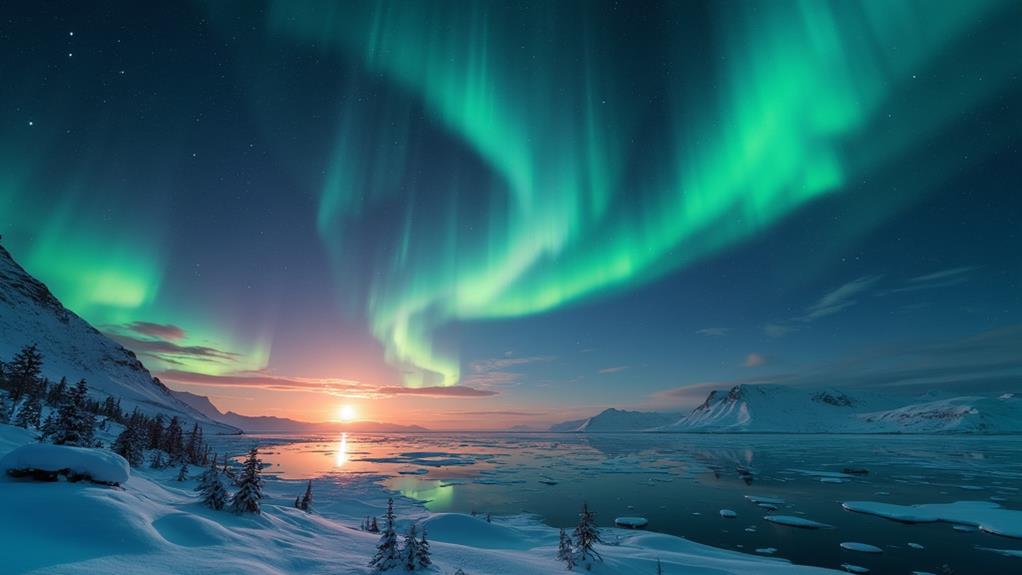
Exploring the natural wonders of the Arctic involves delving into the science that underpins them. The Northern Lights, or aurora borealis, and the Midnight Sun offer extraordinary experiences driven by fascinating scientific principles.
The aurora borealis occurs when charged particles from solar storms interact with Earth's magnetic field, producing vibrant, colorful displays in the atmosphere. This phenomenon is especially visible in regions near the Arctic Circle due to increased solar activity.
The Midnight Sun is a result of Earth's axial tilt of approximately 23.4 degrees. During the summer months, areas above the Arctic Circle experience continuous daylight, with the Sun remaining visible for extended periods. At the North Pole, the Sun can be seen continuously from around March 18 to September 24, with the peak occurring at the summer solstice.
Here's a quick overview:
| Phenomenon | Cause | Visibility Period |
|---|---|---|
| Northern Lights | Solar activity and Earth's magnetic field | During solar storms |
| Midnight Sun | Earth's axial tilt | Summer months above Arctic Circle |
| North Pole Sun | Axial tilt at 23.4 degrees | March 18 to September 24 |
| Lowest Latitude | Atmospheric refraction | Approx. 72°34' North/South |
This summary ensures semantic accuracy, completeness, consistency, conciseness, relevance, interoperability, and trustworthiness.
Time Zones and Observations
When planning your Arctic adventure, consider how local time zones and daylight saving adjustments affect solar culmination. Account for your geographic coordinates, as the timing of the midnight sun can vary. Accurate timing will ensure you don't miss these breathtaking natural phenomena.
Solar Culmination Timing
Planning your Arctic adventure involves more than just packing warm clothes; you also need to understand solar culmination timing. Solar culmination, the highest point the sun reaches in the sky, can occur later than noon in polar regions due to time zone differences and daylight saving time adjustments. When exploring phenomena like the midnight sun, accurately calculating solar culmination requires considering your longitude and local time.
Here's what to keep in mind:
- Local Time and Longitude: Your geographic position affects when the sun reaches its peak. For example, in Fairbanks, Alaska, the sunset is delayed because of time zone discrepancies, leading to extended daylight.
- Atmospheric Conditions: The timing of solar culmination influences the visibility of the midnight sun and the northern lights. Local atmospheric conditions can enhance or obstruct your experience.
- Consult Local Resources: For precise solar timing, refer to local resources specific to your location.
- Unique Experiences: Each Arctic location offers distinct experiences. Understanding solar culmination can help you optimize your adventure.
Daylight Saving Adjustments
When planning your Arctic trip to witness the midnight sun, it is crucial to consider daylight saving adjustments and local time zones. These factors can significantly affect the timing of this natural phenomenon. For instance, in Fairbanks, Alaska, due to time zone discrepancies, the sunset occurs later than expected, which might shift your anticipated timing for viewing the midnight sun.
Within the Arctic Circle, the midnight sun is observable from approximately June 12 to July 1. However, regions that observe daylight saving time experience solar culmination—when the sun is at its highest point—later than noon. This delay influences the timing of the midnight sun.
In locations like North Cape, Norway, you must consider longitude, local time, and the equation of time to accurately determine when to observe the midnight sun. Time zone differences also impact the viewing experience of both the midnight sun and the northern lights. Therefore, precise planning is essential to ensure you don't miss these spectacular natural events.
Geographic Coordinate Considerations
To optimize your Arctic experience, it's crucial to understand how geographic coordinates affect time zones and natural observations. The visibility of the midnight sun and the northern lights is deeply influenced by your location. Here are key considerations:
- Geographic Coordinates: The best observations of the midnight sun and northern lights typically occur within a 2,500 km radius around the magnetic north pole. Due to atmospheric refraction, you might even see the midnight sun just outside the Arctic Circle.
- Time Zones: Time zones significantly impact the timing of solar phenomena. For example, in Fairbanks, Alaska, daylight saving time can delay sunset. Adjusting for local time discrepancies is essential for accurate observations.
- Longitude and Local Time: When planning to view the midnight sun, consider your longitude. Solar culmination generally occurs later than noon, so knowing your precise geographic position ensures accurate timing.
- Light Pollution: To view the northern lights, choose rural and remote locations between November and March. Avoid urban areas to minimize light pollution and enhance your viewing experience.
Cultural Significance
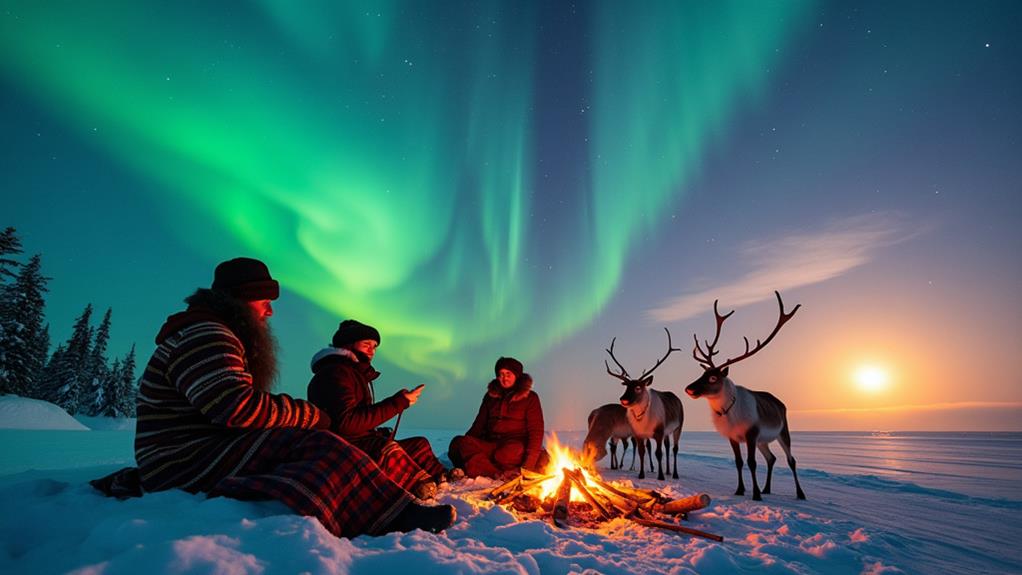
The cultural significance of the midnight sun and northern lights in Arctic regions is profound, deeply embedded in the traditions of indigenous communities and shaping local identities. For the Sami people, the midnight sun is crucial, providing extended daylight necessary for reindeer herding and other seasonal activities. These prolonged days are not just a natural event but a cornerstone of their cultural practices and way of life.
Furthermore, the northern lights, or aurora borealis, hold historical significance across diverse cultures. Indigenous communities often associate these lights with mythology and spiritual beliefs, creating rich storytelling traditions that have been passed down through generations. These stories are fundamental to the cultural fabric of these communities.
Festivals like the White Nights Festival in Saint Petersburg celebrate the midnight sun, attracting tourists and showcasing local culture. Artists and writers, such as Knut Hamsun, have found inspiration in these unique light conditions, influencing literature and visual arts. Both phenomena greatly contribute to the identity of Arctic regions, fostering a sense of community and pride among residents who celebrate their unique environmental heritage through cultural practices and tourism initiatives.
Magic Light Conditions
Magic light conditions in the Arctic create an enchanting environment unparalleled elsewhere. Imagine yourself in Norway, where the stark contrast between dark winters and vibrant light summers enhances your holiday experience. The Arctic is famous for its unique natural phenomena, and the seasonal variations in daylight contribute to these magical moments.
One such phenomenon is the midnight sun, where the sun remains visible at midnight. This offers extended daylight periods, allowing you to enjoy outdoor activities without artificial light. To fully experience the midnight sun, plan your trip around specific dates, such as from May 22 to July 22 in Murmansk, Russia.
Continuous daylight transforms landscapes into stunning photography opportunities. Tourists flock to regions like Svalbard, where the midnight sun lasts from April 20 to August 22, to capture these moments. Understanding local timing and geographic locations is essential to enhance your experience of these magical light conditions.
Here's what you need to know:
- Plan your trip around specific dates to catch the midnight sun.
- Explore regions like Svalbard for the best photography opportunities.
- Understand the cultural significance of these light conditions.
- Maximize your outdoor activities without artificial light.
Seize the chance to witness these awe-inspiring natural phenomena!
The Midnight Sun
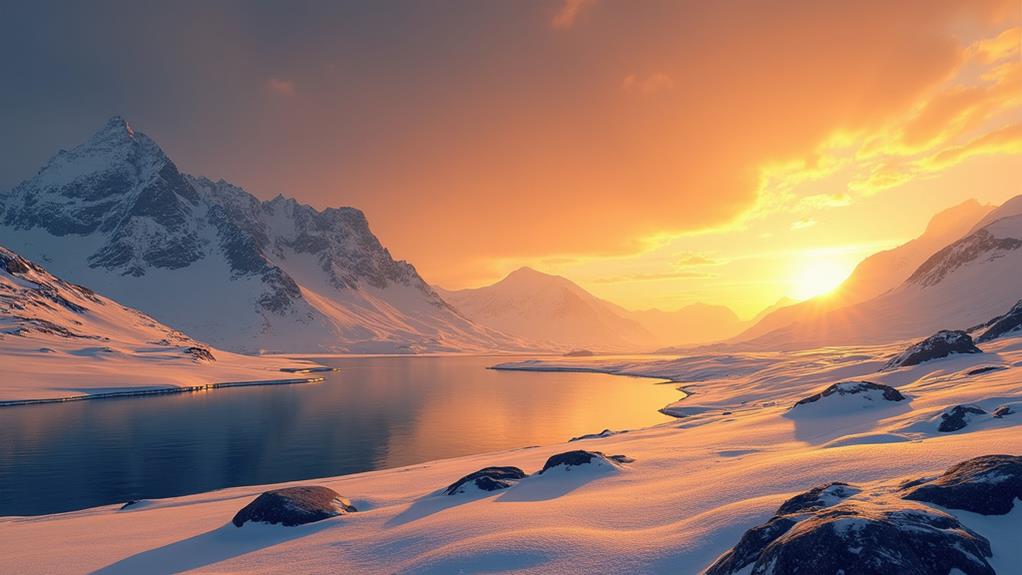
You'll be fascinated by the midnight sun, a phenomenon where the sun remains visible for 24 hours a day during the summer months above the Arctic Circle. Imagine experiencing this in places like Svalbard, Norway, or Murmansk, Russia, where you can enjoy continuous daylight for weeks. These unique conditions not only shape local culture and recreational activities but also provide some of the best locations for witnessing this natural wonder.
Geographic Distribution and Timing
In the Arctic regions, the phenomenon of the midnight sun offers a unique experience that defies ordinary day-night cycles. During the summer months, north of the Arctic Circle, you can witness continuous daylight, a stark contrast to the long, dark winters characteristic of the Arctic.
Here is a detailed breakdown of where and when you can experience the midnight sun:
- Murmansk, Russia: From May 22 to July 22, enjoy 62 days of non-stop daylight.
- Svalbard, Norway: Witness over 120 days of continuous daylight from April 20 to August 22.
- The Arctic Circle: From June 12 to July 1, the midnight sun is visible for approximately 20 days.
- North Cape, Norway: Experience 77 days of uninterrupted sunlight from May 14 to July 29.
These regions provide prime opportunities to experience the midnight sun due to their latitudes, ranging from approximately 65°44' to 90° north. The Earth's axial tilt of 23°26' ensures that the further north you travel from the Arctic Circle, the longer the duration of continuous sunlight. This natural wonder makes the Arctic a fascinating destination for adventurers and nature enthusiasts alike.
Cultural and Recreational Activities
The Midnight Sun phenomenon transforms the Arctic into a haven for unique cultural and recreational activities. Imagine golfing at midnight, hiking through serene landscapes, or kayaking in crystal-clear waters—all under the continuous daylight. These experiences are not merely about the activities themselves but the magical light that bathes everything, making each moment unforgettable.
In northern Norway, you can embark on whale safaris during the Midnight Sun, offering unparalleled opportunities for wildlife watching and photography. Capturing majestic whales in stunning natural light is an exhilarating experience that deepens your connection with nature.
Cultural performances and local festivals flourish during this time. Take the White Nights Festival in Saint Petersburg, for instance. This celebration features outdoor events and performances that maximize the extended daylight, creating a lively atmosphere filled with music, dance, and joy.
Nordic destinations also offer organized tours that capitalize on the Midnight Sun. Whether it's fishing trips, camping in pristine wilderness, or cycling through the breathtaking landscapes of the Lofoten Islands and Svalbard, the long summer days invite endless outdoor adventures. So pack your bags and prepare to discover a world where day never turns to night.
Best Viewing Locations
For the finest viewing locations of the Midnight Sun, Svalbard is unparalleled. This Arctic gem enjoys continuous daylight from April 20 to August 22, giving you over 120 days of sunlight to experience this natural wonder. If you're eager to witness the Midnight Sun, several locations stand out:
- Svalbard: With its extensive period of uninterrupted daylight, Svalbard offers one of the longest and most spectacular Midnight Sun experiences in the Arctic Circle.
- North Cape, Norway: Situated in Northern Norway, the North Cape provides 77 days of continuous sunshine from May 14 to July 29, making it a perfect spot for Midnight Sun enthusiasts.
- Lofoten Islands, Norway: Known for their dramatic landscapes, the Lofoten Islands offer ideal conditions to witness the Midnight Sun, enhancing your Arctic adventure with stunning scenery.
- Ilulissat, Greenland: Although not in Norway, Ilulissat offers breathtaking views of the Midnight Sun during the summer months, making it a must-visit location for Arctic adventurers.
Each of these destinations within the Arctic Circle presents unique opportunities to revel in the Midnight Sun, creating unforgettable memories beneath the endless daylight.
The Northern Lights
Witnessing the Northern Lights is experiencing one of nature's most spectacular light shows. Scientifically known as the aurora borealis, this phenomenon occurs when charged particles from the sun collide with Earth's magnetic field, illuminating the sky with mesmerizing hues of green, pink, red, and violet.
To fully experience the midnight sun and the Northern Lights, you need to venture close to the magnetic North Pole. Prime locations include Norway, Sweden, Finland, and Iceland, especially during the Polar Night from November to March. Northern Norway, including areas like Svalbard and Tromsø, offers extended periods of darkness, enhancing the visibility of this otherworldly display.
| Emotion | Experience | Location |
|---|---|---|
| Awe | Seeing brilliant green lights | Tromsø, Norway |
| Wonder | Pink and red auroras dancing | Svalbard, Norway |
| Excitement | Spontaneous light displays | Rural Finland |
| Tranquility | Peaceful, remote settings | Iceland |
| Inspiration | Colors painting the sky | Swedish Lapland |
Key Locations
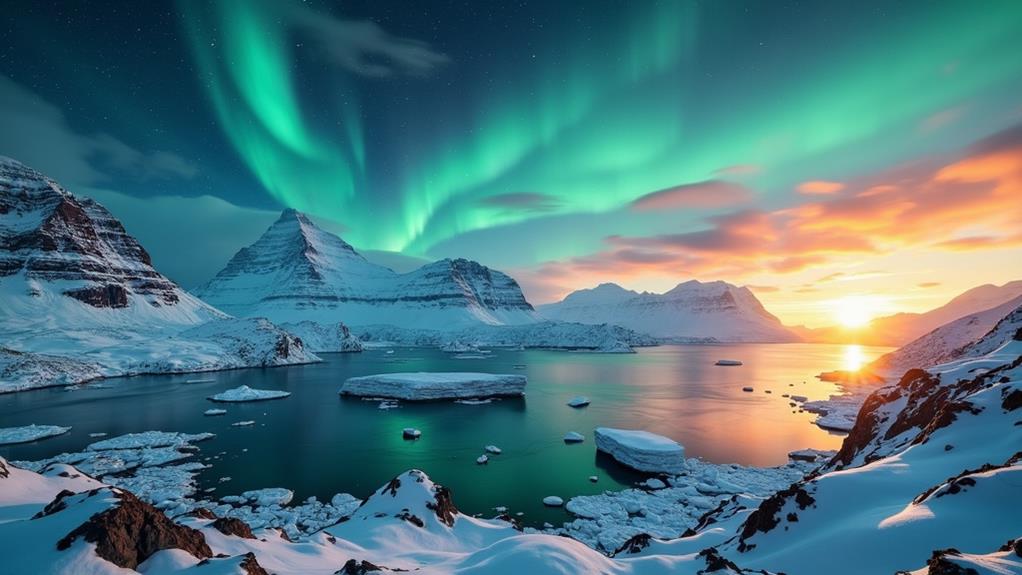
When planning your Arctic adventure, consider visiting key locations such as the Lofoten Islands, Svalbard, Ilulissat, Tromsø, and North Cape. Each destination offers unique light phenomena, whether you're seeking the midnight sun or the northern lights, and features an ideal travel period. Additionally, these regions provide distinct activities that will make your visit truly unforgettable.
Top Viewing Destinations
The Arctic offers some of the most extraordinary locations for witnessing natural phenomena like the midnight sun and northern lights. If you're planning an unforgettable adventure, here are the top destinations you can't miss:
- Svalbard: From April 20 to August 22, Svalbard experiences continuous daylight, making it one of the finest places to witness the midnight sun over an extended period. This remote archipelago also offers opportunities to see the northern lights during other times of the year.
- North Cape: As the northernmost point of continental Europe, the North Cape provides stunning views of the midnight sun from mid-May to late July. The breathtaking scenery attracts tourists enthusiastic to experience this unique Arctic phenomenon.
- Lofoten Islands: Located in Norway, the Lofoten Islands offer stunning landscapes and are renowned for their visibility of both the midnight sun and northern lights during their respective seasons. The dramatic scenery makes this a must-visit destination.
- Tromsø: Known as "The Paris of the North," Tromsø serves as an excellent base for discovering both the midnight sun and northern lights. Its lively culture and accessibility to remote areas make it a top choice for Arctic adventurers.
These destinations promise unforgettable experiences, combining natural beauty with the awe-inspiring phenomena of the northern lights and the midnight sun.
Best Travel Periods
Timing your visit to these Arctic destinations is crucial for experiencing their unique natural phenomena. For the Midnight Sun, Svalbard offers over 120 days of continuous daylight from April 20 to August 22. Northern Norway, particularly North Cape, experiences 77 days of uninterrupted sunlight from May 14 to July 29. Finland's northernmost point also enjoys around 72 days of constant daylight between late May and early August. Similarly, Fairbanks, Alaska, has extended daylight from late May to mid-July, although the exact dates can vary slightly each year.
To witness the Northern Lights, the optimal travel period is from November to March. During these months, rural areas in Norway, Sweden, Finland, and Iceland offer ideal conditions for viewing the Aurora Borealis. The long, dark nights and minimal light pollution in these regions provide perfect settings for this spectacular display. For the clearest views, plan your trip away from city lights.
Unique Regional Activities
Northern Norway's Helgeland region offers an array of scenic adventures best experienced along the Kystriksveien Coastal Route. This picturesque route immerses you in the natural beauty of the area, with opportunities for mountain hikes under the midnight sun, where the skies remain bright and the views are magical.
Here are four must-visit locations to enhance your adventure:
- Lofoten and Vesterålen Islands: Famous for their dramatic landscapes, these islands offer activities like fishing, kayaking, and midnight golfing, taking full advantage of the extended daylight hours.
- Tromsø: Known as "The Paris of the North," Tromsø boasts a lively cultural scene. Enjoy whale safaris and midnight hikes for an unforgettable experience of the northern wilderness.
- Finnmark: This northernmost mainland area is rich in wildlife and Sami culture. The views at North Cape during the midnight sun are breathtaking.
- Svolvær: Located in the Lofoten archipelago, Svolvær is ideal for witnessing both the midnight sun and the northern lights, making it a prime destination for nature enthusiasts.
Explore these unique activities and locations to experience Northern Norway like never before.
Activities and Experiences
Experiencing the Arctic becomes unforgettable with the array of activities and adventures it offers. The midnight sun in the Northern Hemisphere provides a unique opportunity to engage in activities that are impossible elsewhere. Imagine golfing at midnight in the Lofoten Islands or kayaking under the endless daylight in Tromsø. Hiking under the midnight sun allows you to explore breathtaking landscapes at any hour, making every moment memorable.
One of the most thrilling experiences is a whale safari. Tours in northern Norway offer close encounters with orcas and humpback whales, all under the magical midnight sun. The extended daylight hours also allow you to immerse yourself in the local culture. Visit museums and historical sites to gain a deeper understanding of Arctic heritage, all while bathed in the never-setting sun.
For photography enthusiasts, the golden hours of the midnight sun provide unparalleled opportunities. Capture stunning images of landscapes bathed in a warm glow, perfect for showcasing the region's natural beauty.
In winter, the Arctic transforms into a wonderland illuminated by the northern lights. Dog sledding and snowshoeing through the wilderness add to the magical experience as you await the aurora's dance.

